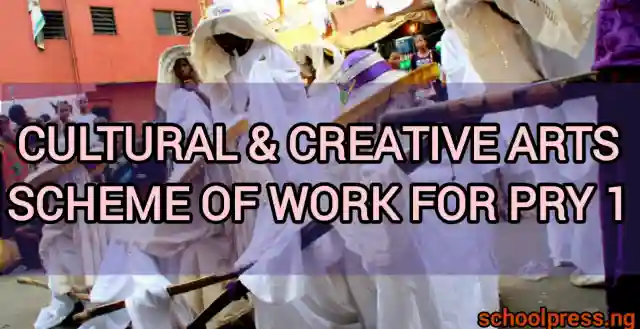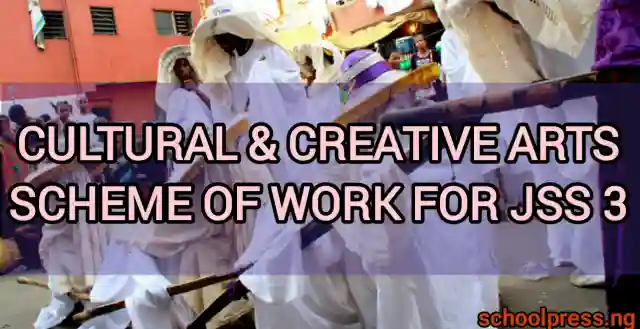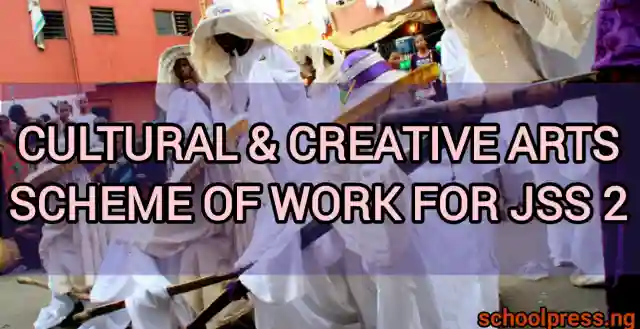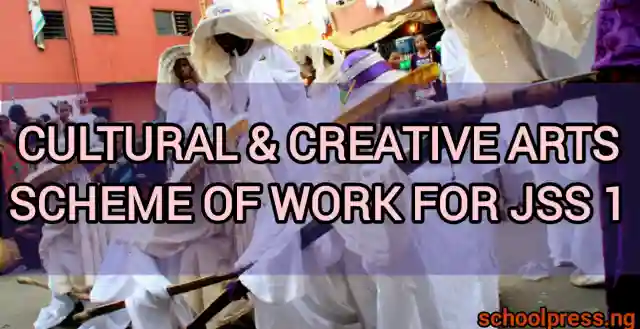Cultural and Creative Arts scheme of work for primary 1 is an organized and detailed plan that directs the teaching and learning of arts and culture in a primary school.
This scheme is designed to help the child acquire the skills, knowledge, attitudes, and values necessary for the child’s development. Furthermore, this scheme provides a foundation for the child’s lifetime learning and participation in the process of arts creation.
Cultural and Creative Arts scheme of work for primary 1 is arranged in four themes and sub-themes that touch on areas of identity, relationships, and society.
In the sub-themes, there are topics with relation to various forms to art such as visual arts, music, drama, and dance. Each topic has objectives, content to be covered, and recommended .
Table of Contents
Objectives Of Cultural and Creative Arts Scheme of Work for Primary 1
First Term Objectives
Week 1: Explain what Art is and Identify types of functional artworks in the home.
Week 2-3: Draw diagrams of functional Art works in the home
Week 4: Recite some traditional rhymes and Identify the lyrics of a given rhymes
Week 5-6: Pupils should be able to mention the uses of rhymes
Week 8-10: Explain the meaning of ceremonies, Identify the different types of ceremonies and Give examples of each type of ceremony
Second Term Objectives
Week 1: Define craft and Identify craft work
Week 2-3: Name different craft works and Identify different crafts in the home
Week 4: Produce a coloured diagram of a craft item
Week 5-6: Identify characters in a story or Folktale and Describe one character in a teacher’s story or a story told in a book
Week 8: Mention the use of role-play
Week 9-10: Mention important values derived from some of the ceremonies and Identify materials associated with Ceremonies
Third Term Objectives
Week 1: Produce a coloured diagram of a craft item
Week 2-3:Identify different craft items and Draw different craft items
Week 4-6: Identify a storyline in a story or folktale and Create or make up a short story
Week 8-9: Mention parts of the body and Identify make-up used on different parts of the body e.g. face, hands and legs
Week 10: Beautifying parts of the body
Read More: 2024 JAMB UTME Form: Know The Important Information For The Exam Registration
Learning Outcomes of Cultural and Creative Arts Scheme of Work for Primary 1
First-Term Learning Outcomes
Week 1: Explain meaning of Arts and Identify functional Art works used in the home
Week 2-3: Illustrate a functional Art work and Apply one colour to the object drawn
Week 4: Recite one children’s rhymes and Identify the lyrics of a given rhymes
Week 5-6: Mention 3 uses of rhymes
Week 8-10: Explain and List the major types of ceremonies, List two ceremonies in their locality
Second Learning Outcomes
Week 1: Explain what craft is
Week 2-3: Name two types Z^T*O’Al”C, and Identify three different crafts in the home
Week 4: Draw and paint a craftwork
Week 5-6: Identify characters in a story and Play out the roles of characters in a story
Week 8: Highlight the uses of role-play
Week 9-10: State two important values derived from some ceremonies and mention two items associated with specific ceremonies
Third Term Learning Outcomes
Week 1: Draw a coloured diagram of a craft item
Week 2-3: Identify two craft items in the home, Illustrate one craft item and Apply colours to their drawing
Week 4-6: Tell the stories they created individually using any one of the outlined themes
Week 8-9: Identify three parts of the body where make-up is applied and Identify two materials for body make-up
Week 10: Apply local make-up to any part of the body
Read More On Primary 1 Scheme of Work
Basic Science Scheme of Work For Primary 1
Islamic Religious Studies Scheme of Work for Primary 1
Basic Technology Scheme of Work for Primary 1
Physical Health Education Scheme of Work For Primary 1
Information Technology Scheme of Work For Primary 1
Mathematics scheme of work for Primary 1
History Scheme Of Work for Primary 1
Christian Religious Studies Scheme of Work for Primary 1
Civic Education Scheme of Work for Primary 1
Social Studies Scheme of Work for Primary 1
First Term Cultural and Creative Arts Scheme of Work for Primary 1
| WEEK | TOPIC | CONTENT |
| 1 | (1) Introduction to Arts | Meaning of Arts |
| 2 & 3 | (2) Functional Arts | The meaning of functional Arts Types of Functional Art works: i. Woven items e.g. mats, baskets, fans etc. ii. Carvings, e.g. carved objects. iii. Drawing of Functional Arts works used in the home. |
| 4 | (1) Children’s Rhymes | Children’s rhymes. |
| 5 & 6 | Children’s Rhymes (contd) | Uses of rhymes |
| 7. | Mid Term Test | |
| 8 – 10 | Ceremonies | Meaning of ceremonies Types of ceremonies Traditional Religious Carnivals National Examples of Ceremonies Traditional – naming, marriage, fishing, durbar, etc. Religious – Christmas, Sallah etc National – Festivals, Arts and culture Festival Carnivals, e.g Abuja, Calabar. etc |
| 11 | Revision | |
| 12 & 13 | Examination |
Read More: Social Studies Scheme of Work for Primary 1
Second Term Cultural and Creative Arts Scheme of Work for Primary 1
| WEEK | TOPIC | CONTENT | |
| 1 | (1) Meaning of Craft | (1) Definition of craft | |
| 2 & 3 | (2) Types of Crafts | Types of Crafts (1) Embroidery Table cloth (ii) Handkerchief Small purseCrafts in the homeWall hangingSimple objects | |
| 4 | Types of Crafts (contd) | (1) Drawing of craft items | |
| 5- 6 | Role Play | Introduce to Role Play Identifying characteristics in a story of folktaleDescribing a character in a storyDramatizing a character in a story | |
| 7 | |||
| 8 | Role Play | Uses of role pay: it helps to teach cooperationIt teaches moral ) It helps children to acquire new skills & idea | |
| 9 & 10 | Ceremonies | Important values derived from ceremoniesMaterials associated with ceremonies e.g Animals, Food, clothing | |
| 11 | Revision | ||
| 12 & 13 | Examination | ||
Third Term Cultural and Creative Arts Scheme of Work for Primary 1
| WEEK | TOPIC | CONTENT |
| 1 | Drawing of different craft items | RevisionDrawing of craft items |
| 2 & 3 | Drawing of different craft items | (1) Examples of craft items BeadsLocal matsLocal clay potsWoven cloths e.g. -“Aso OKe” -“Akwete cloth” -“Saki cloth” – “Campala cloth” |
| 4 – 6 | Introduction to Story telling | Introduction to the art of story tellingMaking up a story line with any one or two of the following themes: Tolerance, service to the nation, Truthfulness, Respect, Obedience etc. |
| 7 | Mid Term Test | |
| 8 | Body Make-Up | Meaning of make-upParts of the Body to be beautified |
| 9 | (2) Displays materials for making-up. | |
| 10 | Beautifying parts of the body | (3) Guides the pupils into beautifying different parts of the body |
| 11 | Revision | |
| 12 & 13 | Examination |
Teacher’s and Pupils Activities
First Term Teacher’s and Pupil’s Activities
Week 1: The teacher should Explain what Art is with visual aids and Explain what functional
Art is. The Pupils should Explain the meaning of Arts and Identify different types of functional Artworks
Week 2-3: The teacher should Show illustrations of functional Art works. The pupils should Draw diagrams of functional Artwork in the home
Week 4: The teacher should Explain what rhymes are, Find out from the pupils the rhymes they are familiar with, Plays recorded rhyme recitation, Display written rhymes on cardboard sheets and Encourage individual and group recitation of rhymes
The Pupils should Recite the traditional rhymes they already know, Listen to the recorded traditional rhymes, Identify rhymes in their language, Copy the written rhymes in their notebooks and Practice reciting of rhymes
Week 5-6: The teacher should guide pupils on the uses of rhymes such as: to preach morals, to develop children’s speech to teach, to showcase our cultural heritage and for entertainment
The Pupils should Mention the uses of rhyme
Week 8-10: The teacher should Explain the meaning of ceremonies, Mention and explain the different types of ceremonies and mention the examples of ceremonies. The pupils should Give examples of ceremonies
Second Term Teacher’s and Pupil’s Activities
Week 1: The teacher should Define what craft is. The Pupils should Listen attentively to the teacher’s explanation
Week 2-3: The teacher should Explain types of crafts and Shows real and illustrated craftwork. The pupils should Identify different crafts and Mention crafts used in the home.
Week 4: The teacher should Group pupils to produce a coloured drawing. The Pupils should Draw and colour a craftwork
Week 5-6: The teacher should Listen attentively to the teacher’s explanation, Observe the teacher’s demonstration and Demonstrate and play roles in traditional stories. The Pupils should Illustrations of characters in a story using charts, pictures etc
Week 8-10: The teacher should Suggest the uses of role play The pupils should Give examples of ceremonies
Week 8-10: The teacher should Explain the important values like unity, honesty, and loyalty derived from the ceremonies, guide the pupils to mention things associated with ceremonies
The pupils should Suggest benefits derived from ceremonies and mention materials associated with specific ceremonies.
Third Term Teacher’s and Pupil’s Activities
Week 1: The teacher should Group pupils to produce a coloured drawing. The pupils should Draw and colour a craft item
Week 2-3: The teacher should Show illustrations of craft items and Group pupils to draw different craft items. The pupils should Identify different craft items, Draw different craft items and Apply colour to their drawing
Week 4-6: The teacher should Explain what storytelling is, Develop a storyline idea, Make up a short story around the idea, Leads the learners to tell stories based on their environment, events or things they watch on television
The Pupils should Listen to the teacher’s explanation follow story line idea in the teacher’s story and make up stories led by the teacher
Week 5-6: The teacher should guide pupils on the uses of rhymes such as: to preach morals, to develop children’s speech to teach, to showcase our cultural heritage and for entertainment
The Pupils should Mention the uses of rhyme
Week 8-10: The teacher should Mention parts of the body to be beautified and display materials for making-up. The pupils should Listen to the teacher’s explanation of traditional local make-up materials and describe familiar local make-up materials.
Week 8-10: The teacher should Guide the pupils into beautifying different parts of the body The pupils should Apply makeup to different parts of the body.
Read More: The Current Official List Of UNIPORT Courses & Programmes






